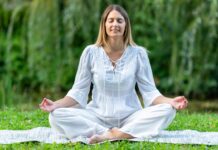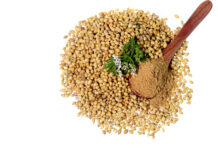A General Practitioner who focuses on integrative health care, Dr Sandra Cabot, looks at how osteoporosis can be managed and even reversed.Â
I see a lot of patients with osteoporosis who have been told that it is impossible to increase bone density. Well, I disagree because the bone is a living structure and is always remodelling itself.
If your bones are dense as determined by a DEXA Bone Mineral Density test this means they are strong because the higher density is caused by a high amount of minerals. Collagen is important for bone density as it gives the bones flexibility so they are not as brittle.
I have patients who have excellent bone density at 75 years of age and other patients who have the bone density of a 90 year old at age 55. I have been able to increase bone density in all my menopausal and post menopausal ladies who show signs of loss of bone density. If you have a family history of osteoporosis or if you are of peri-menopausal age, then I recommend you have a Bone Mineral Density Test.
A mineral deficient diet can lead to loss of bone density. Calcium is not the only mineral needed for a strong skeleton. Magnesium, manganese, zinc, silica, boron, strontium and copper are essential also. Dairy products such as milk, yoghurt and cheese are a source of calcium but some people are allergic to dairy. Foods high in calcium and other minerals include tinned fish (including the bones), broccoli, bok choy, raw nuts and seeds, tahini, hummus, seaweed and legumes.
‘In many people, gluten can reduce the absorption of minerals, especially if consumed in large amounts’
Refined foods are sadly lacking in all of the above-mentioned minerals. These include foods made of white flour and white rice. In many people, gluten can reduce the absorption of minerals, especially if consumed in large amounts.
 Supplements for stronger bones
Supplements for stronger bones
Vitamin D – Vitamin D is essential to absorb calcium from the intestines and to deposit it into the bones. You can take all the calcium but if you are low in vitamin D you will not absorb it!
In addition to skin manufacture from sunlight, vitamin D can be found in some animal foods. It is also available in supplement form, with the current recommendation being that you take between 400 and 1000 IU of vitamin D 3 daily. Many people, especially those who avoid the sun or those living in cold countries, need much more than this and doses of around 5000 IU to 10,000 IU daily may be needed before you can get your blood levels of vitamin D into the higher desirable range.
Make sure that you have an adequate amount of vitamin D in your body, which is an easy thing to check. Ask your doctor to check your blood level of vitamin D. The correct blood test to measure your vitamin D level is called 25(OH) D, also called 25-hydroxyvitamin D3.
Measuring Vitamin D levels
Vitamin D can be measured in two different units of measurement and in the US the units used are ng/mL. In Australia and Canada the units of measurement are nmol/L.
The normal ranges of vitamin D for blood tests reported by different laboratories and countries vary significantly, and you would be surprised to see how large the range is between lower normal and upper normal. See below.
Lower Limit Vitamin DÂ Â Â Â Â Â Â Â Â Â Â Â Â Â Â Â Â Â Upper Limit Vitamin D
75 nmol/LÂ Â Â Â Â Â Â Â Â Â Â Â Â Â Â Â Â Â Â Â Â Â Â Â Â Â Â Â Â Â Â Â Â Â Â Â Â Â Â Â Â Â Â Â Â Â Â Â Â Â Â Â Â Â 200 nmol/L
30 ng/mLÂ Â Â Â Â Â Â Â Â Â Â Â Â Â Â Â Â Â Â Â Â Â Â Â Â Â Â Â Â Â Â Â Â Â Â Â Â Â Â Â Â Â Â Â Â Â Â Â Â Â Â Â Â Â 100 ng/mL
You don’t want to be average here; you want to have levels of vitamin D that optimise strong bones. The optimal levels of vitamin D are higher than the average levels.
You only want to supplement with natural vitamin D3 (cholecalciferol), which is human vitamin D. The synthetic and inferior vitamin D2 does not work as well as D3.
I recommend you take enough supplements of vitamin D3 and-or get enough sunshine to keep your serum vitamin D levels around 150 to 200 nmol/L or 70 to 80ng/mL.
If you have low bone density get your blood level checked every six months to find the dose of vitamin D 3 that keeps you in the optimal levels.
Vitamin K2 takes the calcium that vitamin D has dumped into deposits in the bone, and integrates it or weaves it into the bone structure. This makes the whole structure of the bone stronger.
The latest Vitamin K complex I have formulated provides Vitamin K1 and the MK-4 and MK-7 forms of Vitamin K2 in one daily soft gel capsule. The virtue of this formula is that it provides the precise amount of the long acting MK-7 form of Vitamin K2 that recent human studies have shown provides optimal K2 levels over a 24-hour period. The MK-4 version is also included to provide the rapid increase in vitamin K blood levels that may account for its beneficial effects in certain studies.
How you use your Vitamin D and Vitamin K supplements is important: they are fat soluble and as such must be taken with food that contains some fat for better absorption from the gut.
 To build collagen in the skeleton, I suggest Vitamin C 1000mg daily. Also eat plenty of citrus fruits, bell peppers (capsicums) and berries. Take collagen food powder that contains vitamin C, MSM and silica to increase collagen in the skeleton and make bones more flexible
Calcium
Look for a well-absorbed form of calcium known as calcium hydroxyapatite, plus the other bone essential minerals magnesium, manganese, zinc, silica, boron, copper, vitamin D3 and vitamin K.
Be aware that the cheap form of calcium called calcium carbonate is the most common form of calcium to be advertised and supplemented. Calcium carbonate is the same form of calcium that is found in chalk and is not the best-absorbed form of calcium. I do not recommend it.
‘Research shows strontium improves bone metabolism by promoting new bone formation and decreasing bone breakdown’
Strontium is a naturally occurring mineral present in the soils, food and water. Do not confuse strontium with toxic radioactive Strontium-90, as they have entirely different effects in the body. The nutritional version of strontium can be taken safely in a low dose for years and actually removes radioactive strontium from the body if it is present in any significant amounts.
Trace amounts of strontium are found in the human skeleton and strontium is naturally absorbed at the bone matrix crystal surface. The effects of strontium on bone metabolism have been researched since the 1950s and trials have shown that strontium improves bone metabolism by promoting new bone formation and decreasing bone breakdown; this promotes normalized bone density. Strontium attracts more calcium into the bones; this increases bone density.
Studies conducted at McGill University in the 1980s, and numerous worldwide studies since the 1960s, confirm the bone building and fracture preventive effects of the mineral strontium. Most of the recent research has used strontium ranelate (branded Protos). However, similarly good results can also be achieved with much lower doses and other salts of strontium (such as gluconate, citrate and lactate). I never recommend large doses of strontium, and you need to always check with a qualified natural health care practitioner before taking large doses of any nutrient supplement.
 Menopause and bone density
Menopause and bone density
In patients with low bone density at menopause the mineral strontium in a low dose of strontium citrate 350mg capsules, one daily can improve bone density and works well with vitamin D and vitamin K. In other words, they work synergistically.
Another recognised benefit of strontium supplementation is pain relief as well as re-mineralising of bones affected by cancer metastasis. Strontium supplements also reduce the incidence of dental cavities and improve cartilage metabolism in osteoarthritis. Research indicates that the optimal therapeutic daily dose of strontium supplements is 680 to 1000 mg, however I prefer to start with lower doses in those with sensitive digestive tracts.
Strontium is a useful aid to build bone density especially in people who are intolerant to Bisphosphonate drugs (such as Fosamax or Actonel), or are frightened by their potential side effects, and this includes a lot of people. Furthermore Bisphosphonate drugs can only be taken for five years because of a risk of jawbone necrosis and atypical bone fractures, which do not heal.
Strontium should be taken at night on retiring away from food and away from calcium supplements, because calcium impairs strontium absorption.
People with a history of blood clots or heart disease should not take strontium in high doses and should check with their health care practitioner. It should also be avoided in pregnancy and lactation.
Combining vitamins and minerals
A new study shows how you can help the strontium you’re already taking work even more effectively. In this study, the researchers wanted to find out if taking vitamin D with strontium would maximise the effect of the bone nutrient. We already know that vitamin D is vital for bone health. It works with magnesium and calcium to keep your bones healthy. But this study showed the vitamin-hormone also works to boost strontium’s bone-building ability.
Bone density isn’t the only measure of bone strength you need to evaluate when choosing a bone treatment. That’s because many drugs will increase your bone density. But they will also make your bones more brittle. Strontium won’t have that impact on your bones.
To discover this connection, the researchers looked at 108 women who were taking strontium to fight osteoporosis. They gave the women 25,000 IU (bi-weekly) of vitamin D along with the strontium and measured their bone mineral density after 18 months.
The researchers found that the vitamin D and strontium combination caused “a significant bone mineral density gain.” Given the research on decreased fracture risk, this jump up in bone mineral density is big news.
In this study the researchers used strontium ranelate. This is a pharmaceutical drug in Europe that goes by the name Protelos. It’s a combination of natural strontium and ranelic acid, which is a synthetic molecule. I prefer strontium citrate because both the strontium and the citrate are naturally occurring molecules.
Researchers used 25,000 IU of vitamin D every two weeks. This is more than the average person takes, but still not enough to reach optimum levels. Most integrative physicians are now recommending 3000 to 5000 IU daily. http://www.ncbi.nlm.nih.gov/pubmed/25952299
You need a regular exercise program, even if it is only walking 30 minutes a day. With exercise, it is a case of ‘the more the better’ because exercise has been proven to increase bone density.
Talk to your doctor about the use of bio-identical hormones such as testosterone, oestrogen and progesterone, especially if you have had an early menopause, or if your blood levels of testosterone are very low.
 For further information: www.sandracabot.com
For further information: www.sandracabot.com
REFERENCES
Wright, J.V., Fight – Even Prevent – Osteoporosis with the hidden secrets of this bone-building miracle mineral. (Reprint from Nutrition and Healing. Tahoma Clinic, 2008).
DeHart, S.S. (July 7, 2008). Strontium and Osteoporosis: A treatment not offered to American Women
Dean, W. (May 2004) Strontium breakthrough against Osteoporosis








































